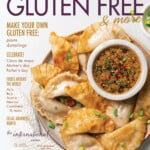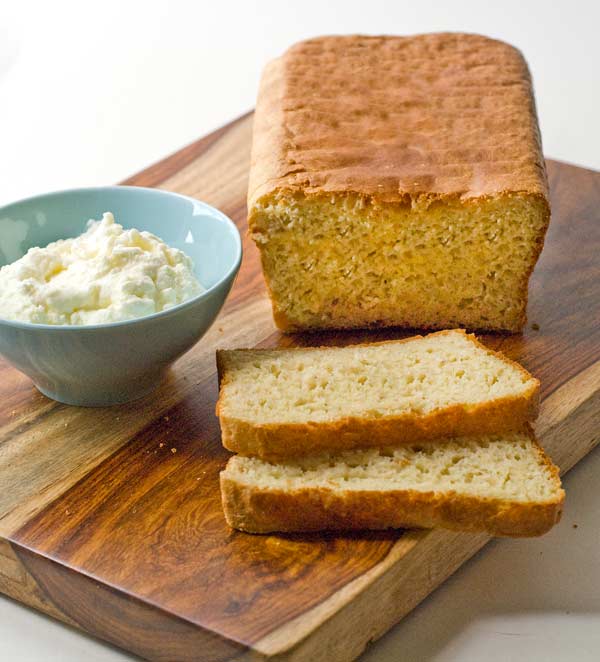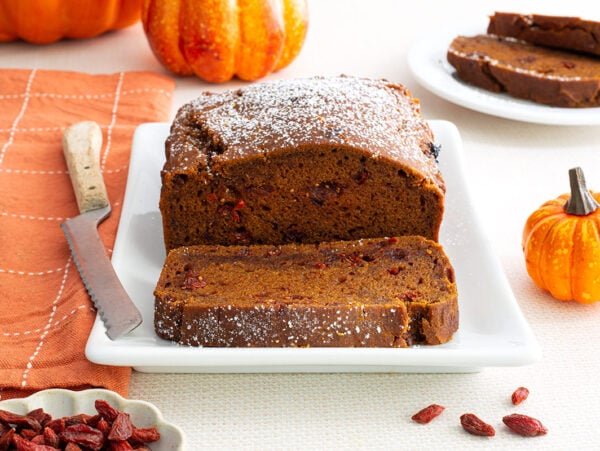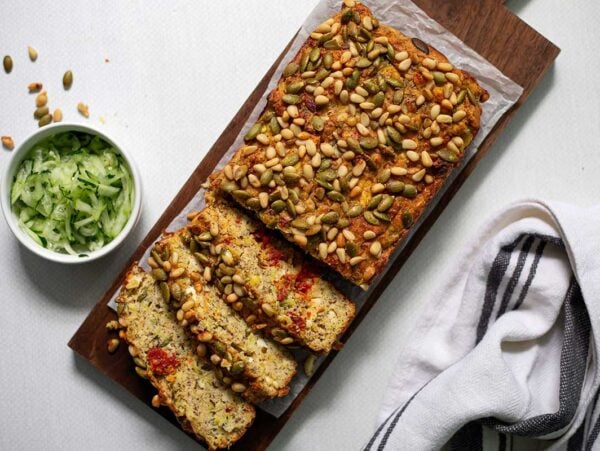Gluten Free Soft Bread Recipe
Updated Jun 13, 2018, Published Apr 03, 2013
This post contains affiliate links. Please see our disclosure policy.
For most people, a bread binge is consuming a lot of bread in a short period of time. For me, it is baking a lot of bread in a short period of time.
I was on a quest for an incredibly easy, soft, gluten free white (or sandwich) bread recipe that literally anyone could make. And since I have no patience, I wanted to be able to enjoy warm bread in an hour or so not an afternoon.
Aside from being dead simple to make, quick, soft, and tasty, I wanted the bread to be gum free. Psyllium husks are great for use in gluten free baking, they are cheaper and easier to come by than xanthan gum and don’t cause the tummy upsets that gums can for some people. While I have used psyllium husks in gluten free baking I had yet to try it in bread.
I feel a little bit of a ramble coming on so if you would prefer to just scroll down and get to the recipe, be my guest!
The first loaf I baked tasted fantastic, it was light, moist, and soft, it rose up beautifully and sliced well – pretty much everything I wanted – except it sunk in the middle. Not a lot, but enough to send me back to the drawing board (or in this case, kitchen.)
I should tell you that my husband said I could call the recipe a success; he loved the first loaf and didn’t understand why a little sinking in the center was such an issue. Additionally he thought the answer to the problem was to let the bread cool upside down on the cooling rack. I should also tell you that he is not a recipe developer and never will be.
So began the painstaking process of changing just on tiny thing at a time; a half teaspoon less yeast, a tad less salt, more sugar, less water, more psyllium husks, less psyllium husks… With each tiny correction I came closer and closer and the dent in the center began less and less pronounced.
The final change was to swap out the water I had been using in the recipe with milk; I figured a tad more protein couldn’t hurt. That did it – no more sinking!
Although I didn’t try it, I am thinking if you are dairy free you can use a high protein milk substitute like soy or you can just use water, it will sink slightly in the middle but it will still be soft, tasty, quick, easy, and gum free! And you can always try the letting the bread cool upside down suggestion from my hubby.
Prior to creating this Gluten Free Soft Bread recipe, I always thought a good stand mixer was essential to baking homemade gluten free bread. Interestingly, this recipe worked best with just a bowl and a whisk. Yep. Seriously, this recipe just keeps getting easier and easier.
Here are a few more thoughts and notes about the recipe, just in case you are interested.
- I used Erawan brand white rice flour, glutinous (sweet rice) flour, and tapioca starch. Asian flours are milled finer thus giving superior results when you are looking for a soft, even texture and they are about a third of the price of the flours and starches you get at the health food store.
- Look for psyllium husks in the supplement department of your health food store; it is typically sold where they sell colon cleansers and such. Try not to think about that when you are buying it.
- Be sure to grease AND flour your loaf pan; if you just grease it your bread may get a little soggy at the bottom.
- Heat your milk or water to warm (about 110 degrees) not hot. If you stick your finger in it, the liquid should feel warm and you can keep your finger in there for several seconds comfortably.
- Let your yeast proof until it is has a nice head of foam (like a glass of beer) about an inch thick. If you store your yeast in the fridge, it may take about 10 minutes.
- Measure your psyllium husks carefully. Trust me, after making 19 loaves of bread I found that exactly 1 level tablespoon is the correct amount.
- The batter for this bread is thinner than you might expect – it is similar to a thick pancake batter.
- Don’t let your batter rise too much; it should come just under the top of your pan for the best results.
So there you have it, soft, gluten free bread that could not be easier. Enjoy!
And one last thing! To make thing even easier, click here to see my cooking demonstration of this recipe on Daytime TV.

Gluten Free Soft Bread Recipe
Ingredients
- 1¼ cups warm, 110 degrees milk
- 4½ teaspoons dry active yeast
- 3 tablespoons sugar, divided use
- 1½ cups superfine or Asian white rice flour
- 1 cup tapioca starch
- ½ cup glutinous, sweet rice flour plus more for preparing the pan
- 1 tablespoon psyllium husks powder
- 1 teaspoon kosher salt
- 3 large eggs
- ¼ cup grapeseed or vegetable oil plus more for preparing the pan
Instructions
- Whisk together the milk, yeast, and 1 tablespoon of sugar. Let sit until the yeast has proofed (almost double in size with a head of foam about 1 inch thick), 5 – 10 minutes.
- Grease a 9.25 by 5.25 by 2.75 inch loaf pan with oil. Sprinkle in some sweet rice flour, coat the pan, and tap out the excess.
- Whisk the rice flour, tapioca starch, sweet rice flour, psyllium husks powder, salt, and remaining 2 tablespoons of sugar. Add the proofed yeast mixture, eggs, and oil, and whisk until smooth and lump free. Pour into the prepared pan, cover with a clean tea towel and let rise in a warm, draft free environment for 20 or 25 minutes or until the batter comes almost to the top of the pan. Preheat the oven to 375 while the bread is rising.
- Bake the bread for 30 – 40 minutes or until golden brown. Let cool in the pan then remove to a wire rack to finish cooling.
Nutrition
Nutrition information is automatically calculated, so should only be used as an approximation.
The views and opinions expressed on this blog are purely the blog owner’s. This blog accepts free manufacturers’ samples and forms of cash advertising, sponsorship, paid insertions or other forms of compensation. Affiliate links may be included in this post.
















Hi Carol,
Is the Sweet rice Flour superfine as well?
Nancy,
Yes, I typically use erawan, which you can find at Asian markets. It’s a lot less expensive than the super fine sweet rice flour that you generally find in health food stores. xo, Carol
Hi Carol
Can I replace the sweet rice flour with normal rice flour? Sweet rice flour is difficult to get it in my city.
Lucy,
Yes, it wont be exactly the same, the sweet rice flour sort of evens out the texture and helps with browning, but it should still be very acceptable. Enjoy!
xo,
Carol
Hi Carol, I just tried your recipe and my bread came out delicious I substituted the psyllium with xanthan gum and added cinnamon and raisins and it was delicious. Thank you!
Carol I also went to an Asian market for the different flours, thanks for that tip, the 16 oz bags were 99 cents.
Hi Carol, thank you for ALL the information! Would a thermometer to test the internal temperature of this bread be helpful, and if ‘yes’, what would be the ideal temperature to show the bread is done? Thanks.
Virginia,
You can try it. Around 200F° should be good.
xo, Carol
hi- I am planning to make your flour mix, and also to make a couple of your breads. First, I went to get some erawan sweet rice flour on amazon(prime), and it was $5.75 per 16 oz. bag. Is that comparable to what you buy? I would like to know the cheapest way to get this stuff. thx for everything, Jill
Hi Jill,
Yes, I use Erawan. I often get it at an Asian foods market for slightly less, but $5.75 per 16 oz. is not a bad price. Hope this helps!
xo,
Carol
If I replace the flours and starch in this bread recipe with “your” flour, how much xanthan gum do I add? And do I still use the psylliym powder that it calls for if I add the xanthan gum?
Hi Mary,
If you use my flour blend, you won’t need to use the psyllium husk powder, because the flour contains xanthan gum (and no need to add any additional xanthan gum to the bread recipe). Just replace the white rice flour, tapioca starch, and sweet rice flour with equal parts of my all-purpose flour and you should be good to go!
xo,
Carol
Carol, Thank you for clearing this up for me, but I’m still alittle confused. I asked my question in response to earlier comments in Oct. 2013 where someone asked if they could use “your” flour in this recipe. You stated yes, just substitute the flour and starches with “your “flour but still add the xanthum gum. Also, at the bottom of “your” flour blend recipe, you made the following note: For recipes with yeast, add 3/4 tsp of addt’l xanthan gum per cup of flour called for in the recipe. Am I misreading? I’m anxious to make this for Thanksgiving.
Hmm… yes, Mary, on second thought you are right about the xanthan gum. Sorry about the confusion. Using my flour, leave out the psyllium husks and add xanthan gum – 3/4 teaspoon per cup of flour called for in the recipe. Let me know how it goes, and I hope you have a wonderful Thanksgiving!
xo,
Carol
Carol,
I made the bread using your flour blend, left out the psyllium husk powder and added the extra xanthan gum(3/4 tsp per cup of flour). The dough was rather thick, definitely not like pancake batter, more like regular bread dough. It turned out okay, but alittle heavy. I did use alittle more yeast as I didn’t think the yeast was rising well. Would that have made the batter so thick? I think I may buy some psyllium husk powder(as I didn’t have any on hand earlier) and follow the recipe with not exceptions. Hopefully I will have better luck.
Every other gluten-free bread I have seen has been the size of melba toast! I’ve made your bread a few times now, and it is terrific! I will say I substituted xanthan gum which I had on hand instead of psyllium powder, and used melted butter instead of oil. I am so glad to have bread that can be used for sandwiches as well as French toast!
This is a terrible recipe. First, the dough was too tough to even stir, let alone “whisk”. The bread did rise just fine but it collapsed onto itself while in the oven, after the first 15 minutes or so (and no, I did not let it rise more than I should have). Then the inside was uncooked. The inside was gooey and sticky and raw after 45 minutes, so much that it was sticking on the bread knife even after it was cold. This bread was impossible to cook through, and impossible to keep its shape. By the way, I am not inexperienced in baking, and I did measure my ingredients. The recipe is just a bad one.
Hi Nazli,
I’m sorry it didn’t turn out right for you. This bread recipe has been on the site for years and I’ve received mostly good comments about it, although there have been some people who had the issue with it sinking in the middle. If you check out the comments you might find some of the conversations between readers and myself about the issue with the bread sinking, and that might help figure out what went wrong. One woman was curious if the high altitude she lived at was causing the problem – are you at a high altitude? Another suggestion I’ve given is that you might want to let it rise for a shorter period of time – just enough time for it to be level with the pan, not higher than the pan. And then there’s the last-stitch fix of flipping the pan upside down on a wire rack to cool, with the intention of letting gravity un-sink the center a little bit.
As far as the inside being uncooked, I don’t think anyone has come to me with that issue before and if you cooked it 45 minutes I’m not sure why that would happen. Did you substitute any ingredients by chance? And how accurate is the temperature of your oven? If you have an oven-proof thermometer, perhaps double check that the temp on your oven is correct.
Let me know if you have any questions. If you try the recipe again, let me know how it does.
Thanks!